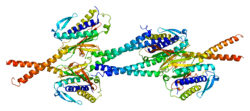MAD1L1
Mitotic spindle assembly checkpoint protein MAD1 is a protein that in humans is encoded by the MAD1L1 gene.[5][6][7]
MAD1L1 is also known as Human Accelerated Region 3. It may therefore have played a key role in differentiating Humans from Apes.
Function
MAD1L1 is a component of the mitotic spindle-assembly checkpoint that prevents the onset of anaphase until all chromosome are properly aligned at the metaphase plate. MAD1L1 functions as a homodimer and interacts with MAD2L1. MAD1L1 may play a role in cell cycle control and tumor suppression. Three transcript variants encoding the same protein have been found for this gene.[7]
Interactions
MAD1L1 has been shown to interact with:
gollark: Tux1 antimemetically said I could.
gollark: ↓ Tux1, on video
gollark: ↓ captured image of tux1
gollark: Not sure that's true by any reasonable definition but "okay".
gollark: Great?
See also
References
- GRCh38: Ensembl release 89: ENSG00000002822 - Ensembl, May 2017
- GRCm38: Ensembl release 89: ENSMUSG00000029554 - Ensembl, May 2017
- "Human PubMed Reference:". National Center for Biotechnology Information, U.S. National Library of Medicine.
- "Mouse PubMed Reference:". National Center for Biotechnology Information, U.S. National Library of Medicine.
- Jin DY, Kozak CA, Pangilinan F, Spencer F, Green ED, Jeang KT (May 1999). "Mitotic checkpoint locus MAD1L1 maps to human chromosome 7p22 and mouse chromosome 5". Genomics. 55 (3): 363–4. doi:10.1006/geno.1998.5654. PMID 10049595.
- Jin DY, Spencer F, Jeang KT (May 1998). "Human T cell leukemia virus type 1 oncoprotein Tax targets the human mitotic checkpoint protein MAD1". Cell. 93 (1): 81–91. doi:10.1016/S0092-8674(00)81148-4. PMID 9546394.
- "Entrez Gene: MAD1L1 MAD1 mitotic arrest deficient-like 1 (yeast)".
- Yoon YM, Baek KH, Jeong SJ, Shin HJ, Ha GH, Jeon AH, Hwang SG, Chun JS, Lee CW (September 2004). "WD repeat-containing mitotic checkpoint proteins act as transcriptional repressors during interphase". FEBS Lett. 575 (1–3): 23–9. doi:10.1016/j.febslet.2004.07.089. PMID 15388328.
- Rual JF, Venkatesan K, Hao T, Hirozane-Kishikawa T, Dricot A, Li N, Berriz GF, Gibbons FD, Dreze M, Ayivi-Guedehoussou N, Klitgord N, Simon C, Boxem M, Milstein S, Rosenberg J, Goldberg DS, Zhang LV, Wong SL, Franklin G, Li S, Albala JS, Lim J, Fraughton C, Llamosas E, Cevik S, Bex C, Lamesch P, Sikorski RS, Vandenhaute J, Zoghbi HY, Smolyar A, Bosak S, Sequerra R, Doucette-Stamm L, Cusick ME, Hill DE, Roth FP, Vidal M (October 2005). "Towards a proteome-scale map of the human protein-protein interaction network". Nature. 437 (7062): 1173–8. Bibcode:2005Natur.437.1173R. doi:10.1038/nature04209. PMID 16189514.
- Sironi L, Melixetian M, Faretta M, Prosperini E, Helin K, Musacchio A (November 2001). "Mad2 binding to Mad1 and Cdc20, rather than oligomerization, is required for the spindle checkpoint". EMBO J. 20 (22): 6371–82. doi:10.1093/emboj/20.22.6371. PMC 125308. PMID 11707408.
- Murakumo Y, Roth T, Ishii H, Rasio D, Numata S, Croce CM, Fishel R (February 2000). "A human REV7 homolog that interacts with the polymerase zeta catalytic subunit hREV3 and the spindle assembly checkpoint protein hMAD2". J. Biol. Chem. 275 (6): 4391–7. doi:10.1074/jbc.275.6.4391. PMID 10660610.
This article is issued from Wikipedia. The text is licensed under Creative Commons - Attribution - Sharealike. Additional terms may apply for the media files.






